

ĭefinitions By Adler, Konheim and McAndrewįor an open cover \(\mathcal\)). The most important characterization of topological entropy in terms of Kolmogorov-Sinai entropy, the so-called variational principle was proved around 1970 by Dinaburg, Goodman and Goodwyn. Equivalence between the above two notions was proved by Bowen in 1971. It uses the notion of \(\varepsilon\)-separated points. In metric spaces a different definition was introduced by Bowen in 1971 and independently Dinaburg in 1970. Then to define topological entropy for continuous maps they strictly imitated the definition of Kolmogorov-Sinai entropy of a measure preserving transformation in ergodic theory.

Their idea to assign a number to an open cover to measure its size was inspired by Kolmogorov and Tihomirov (1961). Given an irreducible subshift of nite type X, a sub- shift Y, a factor map : X Y, and an ergodic invariant measure on Y, there can exist more than one ergodic measure on X which projects to and has maximal entropy among all measures in the ber, but there is an explicit bound on the number of such maximal entropy preimages. The original definition was introduced by Adler, Konheim and McAndrew in 1965. 8.5 Topological entropy for nonautonomous dynamical systems.8 Generalizations of topological entropy.7.1 Topological tail entropy and symbolic extension entropy An important class of subshifts consists of the irreducible shifts: Definition 10 A subshift X is irreducible (aka.6 Topological entropy in some special cases.5 Relation with Kolmogorov-Sinai entropy.4 Basic properties of topological entropy.arise from geometric considerations involving the Rauzy graphs of the subshift. In what follows \(\log\) denotes \(\log_2\) (although this choice is arbitrary). in a natural way a profinite group to each irreducible subshift. Roughly, it measures the exponential growth rate of the number of distinguishable orbits as time advances. Topological entropy is a nonnegative number which measures the complexity of the system. Let \((X,T)\) be a topological dynamical system, i.e., let \(X\) be a nonempty compact Hausdorff space and \(T:X\to X\) a continuous map. The number of orbits distinguishable in \(n\) steps grows as \(2^n\ ,\) generating the topological entropy \((1/n)\log_2(2^n) = 1\. The class of normal subshifts includes irreducible nontrivial topological Markov shifts, irreducible nontrivial sofic shifts, synchronized systems. Similarly, there are eight points (the black points), whose orbits are similarly distinguished in three steps (after one iterate the black points become the red and yellow points, after another iterate they become the blue, violet and green points). But there exist already four different points whose orbits can be distinguished in two steps: the red points are mapped onto the blue and violet points and any two of them are distinguished either immediately or after applying the transformation once. Initially there are at most two distinguishable points, for example, the blue points. Suppose that only points that are in opposite halves of the rectangle can be distinguished. The video on this page was distributed as a pre-recorded session ahead of a second live lecture.Figure 1: Topological entropy generated in a so-called horseshoe: the rectangle is stretched, bent upward and placed over itself. Joint work with Luísa Borsato, with extensive advice from Brian Marcus and Tom Meyerovitch. As far as we know, this is the first reasonably general result of the Lanford-Ruelle type for a class of subshifts without the topological Markov property. As an application in one dimension, we show that for a sufficiently regular potential, any equilibrium measure on an irreducible sofic shift is Gibbs.

We will also discuss forthcoming work, in which we show that Gibbsianness is preserved by pushforward through a certain kind of almost invertible factor map. We will discuss two of these definitions, one introduced by Capocaccia and the other used by Dobrushin-Lanford-Ruelle, and outline a proof (available at ) that they are equivalent. There are multiple definitions of a Gibbs measure in the literature, which do not always coincide. Classical results of Dobrushin and Lanford-Ruelle establish, in rough terms, that for a local energy function on a subshift without too much long-range order, the translation-invariant Gibbs measures are precisely the equilibrium measures.


 0 kommentar(er)
0 kommentar(er)
